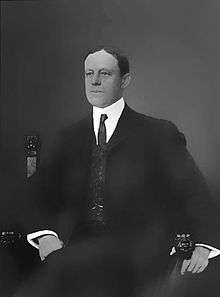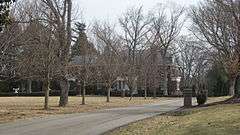Morris B. Belknap
| Morris B. Belknap | |
|---|---|
 Portrait of Belknap from Johnson's A History of Kentucky and Kentuckians (1912) | |
| Born |
Morris Burke Belknap June 7, 1856 Louisville, Kentucky |
| Died | April 13, 1910 (aged 53) |
| Cause of death | Pernicious anemia |
| Resting place | Cave Hill Cemetery |
| Alma mater | Sheffield Scientific School (Yale University) |
| Occupation | Businessman |
| Known for | Vice-president of Belknap Hardware and Manufacturing Company; nominee for Governor of Kentucky |
| Political party | Republican |
| Religion | Christian (Presbyterian) |
| Spouse(s) |
Lily Buckner (m. 1883; d. 1893) Marion S. Dumont (m. 1900) |
| Children | 4 |
| Parent(s) | William Burke Belknap and Mary (Richardson) Belknap |
| Relatives | Son-in-law of Simon Bolivar Buckner |
| Signature | |
|
| |
Morris Burke Belknap (June 7, 1856 – April 13, 1910), also known as Colonel Morris Burke Belknap, was a businessman from Louisville, Kentucky, who was the Republican nominee for Governor of Kentucky in 1903. After earning a degree from the Sheffield Scientific School of Yale University, he worked at his father's hardware company. Later, he co-founded an agricultural implement company. In 1883, he married Lily Buckner, with whom he fathered four children. Following the death of his father, Belknap became vice-president of his hardware company, a position which he held for the rest of his life. Lily Buckner Belknap died in 1893, and he married Marion S. Dumont in 1900.
In addition to his business career. Belknap served in the Kentucky State Guard, eventually rising to the rank of lieutenant colonel. In 1898, during the Spanish–American War, he served briefly in Puerto Rico prior to the end of hostilities. He was promoted to colonel before his honorable discharge in 1899.
In 1903, Belknap accepted the nomination for state governor after being chosen at the Kentucky Republican convention in that year. He campaigned on his business experience and opposition to policies of the current governor, but he was ultimately defeated by the incumbent J. C. W. Beckham.
After his unsuccessful gubernatorial run, he spent his later life involved in a variety of civil and religious organizations. On April 13, 1910, he died of pernicious anemia, a condition which is believed to have been worsened by a mysterious ailment he contracted while in Puerto Rico.
Early life and family
Belknap was born at his parents' home in Louisville, Kentucky, on June 7, 1856.[1] He was the youngest child of William Burke and Mary (Richardson) Belknap.[2] Until the age of 17, he was educated in the private school of Benjamin B. Huntoon.[1][2] In 1873, he and his brother, William Richardson Belknap (1849–1914), spent a year traveling in Europe.[1][3] On his return, he enrolled in the Sheffield Scientific School of Yale University, where he was a classmate of future U.S. President William Howard Taft.[1] He earned his degree in 1877, but spent an additional year of postgraduate study in chemistry.[1][3]
Returning to Louisville in 1879, Belknap worked for his father's hardware company, W. B. Belknap and Company, for a short time before partnering with Thomas Miekle and Barry Coleman to form Thomas Miekle and Company, an agricultural implement manufacturer.[2] He returned to W. B. Belknap and Company in 1883 as a secretary.[2]
On June 14, 1883, Belknap married Lily Buckner, the daughter of Confederate general Simon Bolivar Buckner.[4] The couple had four children – Gertrude, Walter Kingsbury, Lily, and Morris, Jr.[4] Lily Belknap died in 1893.[4] After her death, Belknap constructed a stone bridge – dubbed Belknap Bridge – in Louisville's Cherokee Park in her honor.[5][6]
Belknap's father died in 1889, and after incorporating his company as Belknap Hardware and Manufacturing Company, Morris Belknap became the company's vice-president, a position he held for the remainder of his life.[1] As vice-president, he began promoting his company on a national scale and became one of the South's leading businessmen.[2] He was the youngest person elected president of the Louisville Board of Trade, and he held that position for many years.[1]
Military service
In 1879, Belknap enlisted as a private in the First Infantry Regiment of the Kentucky State Guard, known as the Louisville Legion.[1] His father-in-law was elected Governor of Kentucky in 1887 and appointed Belknap to his military staff with the rank of colonel.[4] In 1890, he was elected captain of Company A of the First Regiment in the Kentucky State Guard, and in 1893, he was chosen as the unit's lieutenant colonel.[4]
At the commencement of the Spanish–American War, Governor William O'Connell Bradley called up Belknap's unit for service.[2] He was mustered into federal service on May 13, 1898, and departed the same day, spending several weeks at Lexington, Kentucky, before arriving at Newport News, Virginia, on July 28, 1898.[4] On August 1, General Frederick Dent Grant ordered six companies under Belknap to board the USRC Hudson bound for Puerto Rico.[4] Arriving at Ponce on August 11, the men were forwarded to Mayagüez by General Nelson A. Miles.[4] The next day, the men disembarked and were ordered by General Theodore Schwan to follow the 11th Infantry Regiment inland as soon as transport could be secured.[4]
On August 13, a special messenger informed Schwan that hostilities had ceased.[4] Belknap and his men remained at Mayagüez until August 26, then returned to Ponce, reuniting with the regiment's six other companies under John Breckinridge Castleman on August 29 and 30.[4] Upon Castleman's elevation to brigadier general, Belknap was promoted to colonel and given command of the First Kentucky.[2] The unit returned to Louisville on December 12, 1898; Belknap was honorably discharged on February 24, 1899.[2][4] Although he saw no active service, Belknap contracted a mysterious disease in Puerto Rico from which he never fully recovered and which was believed to have contributed to his death.[2]
On July 16, 1900, Belknap married Marion S. Dumont of Plainfield, New Jersey.[4]
Campaign for governor
At the 1903 Republican state convention, party leaders John W. Yerkes and W. Godfrey Hunter supported Belknap as the party's gubernatorial nominee.[7] Former governor Bradley, however, supported a fellow Louisvillian, attorney Augustus E. Willson.[7] When a pro-Willson delegation was unseated by a challenge, Willson withdrew and Bradley bolted the convention.[7] Consequently, Belknap was chosen as the party's nominee on the first ballot.[7][8] With the Democrats divided by factionalism, the Republicans tried to woo erstwhile Democrats by nominating former Democratic congressman William M. Beckner for a down-ballot office.[7] Former Democratic governor Buckner also supported his son-in-law's candidacy.[9]
Belknap touted his business management experience, contrasting it with charges that his opponent, incumbent Governor J. C. W. Beckham, had mismanaged the state's eleemosynary institutions.[7] He also attacked Beckham for having risen to power by building a political machine.[7] Belknap lacked name recognition outside Louisville. He was a poor public speaker, and he was unable to make the race truly competitive.[7] The New York Times reported, "Col. Morris B. Belknap, the Republican nominee for Governor of Kentucky, is an athlete as well as a politician and a millionaire businessman. It has just leaked out that the Colonel used his muscles with good effect the other day in order to keep a speaking appointment at Central City, where several hundred coal miners had assembled to hear him speak. He missed his train at Russellville and tried to make the trip to Central City by driving. Fearing that he would be too late, he arranged for a hand-car at a small station. Two men were given him to pump him over to Central City. They became tired and the Colonel relieved them by taking a hand himself. He worked desperately and the hand-car pulled into the little town a few minutes ahead of time."[10] Election day was a rowdy one throughout the state, and a judge supporting Belknap was shot by a sheriff at a polling place in Louisville.[11] Victory went to Belknap's opponent, and Beckham won the election 229,014 to 202,764, marking the first time in sixteen years that the Democrats had gained a majority of the votes cast.[7]
Later life
Belknap continued to be active in business, attending the International Congress of Chambers of Commerce in Liège in 1905.[4] From 1907 to 1909, he was chairman of the Louisville Board of Parks.[2] He was a member of several civic and religious organizations, including the Pendennis Club, the Louisville Country Club, the Salmagundi Club of Louisville, and the Warren Memorial Presbyterian Church of Louisville, where he was a deacon and chairman of the board of trustees.[4] He was president of the Yale Alumni Association in Louisville and director of that city's YMCA.[4]

Belknap fell ill in late 1907, and his poor health continued into mid-1908.[12] In July 1908, he traveled to Europe in order to improve his health, but after his return in October, his condition worsened again.[12] From January to June 1909, he was bedfast.[12] In early April 1910, he fell into a coma from which he never awakened.[12] He died of pernicious anemia on April 13, 1910, and was buried in Cave Hill Cemetery.[2] The Midlands, a private house in Louisville listed on the National Register of Historic Places, was built (1913–1914) for Marion Dumont Belknap after her husband's death.
References
- 1 2 3 4 5 6 7 8 Johnson, E. Polk (1912). A History of Kentucky and Kentuckians: The Leaders and Representative Men in Commerce, Industry and Modern Activities. 3. Chicago, Illinois: Lewis Publishing Company. p. 1154.
- 1 2 3 4 5 6 7 8 9 10 11 Stephens, Thomas E. (2001). "Belknap, Morris Burke". In John E. Kleber. The Encyclopedia of Louisville. Lexington, Kentucky: The University Press of Kentucky.
- 1 2 "Obituary Records of Graduates of Yale University". Bulletin of Yale University. Yale University. 6 (9): 1311–1312. July 1910.
- 1 2 3 4 5 6 7 8 9 10 11 12 13 14 15 16 Johnson, E. Polk (1912). A History of Kentucky and Kentuckians: The Leaders and Representative Men in Commerce, Industry and Modern Activities. 3. Chicago, Illinois: Lewis Publishing Company. p. 1155.
- ↑ Johnson, E. Polk (1912). A History of Kentucky and Kentuckians: The Leaders and Representative Men in Commerce, Industry and Modern Activities 3. Chicago, Illinois: Lewis Publishing Company. p. 1154.
- ↑ Belknap Bridge. :: Claude C. Matlack Collection
- 1 2 3 4 5 6 7 8 9 Klotter, James C. (1996). Kentucky: Portraits in Paradox, 1900–1950. The University Press of Kentucky. ISBN 0-916968-24-3.
- ↑ "BELKNAP WINS. Bradley's Name Placed Before Convention Without His Consent. Pratt Secures Next Greatest Amount of Votes—Wilson's Name Not Mentioned.". The Bee. Earlington, Kentucky. July 23, 1903 – via Newspapers.com.

- ↑ Tapp, Hambleton; James C. Klotter (1977). Kentucky: Decades of Discord, 1865–1900. Lexington, Kentucky: The University Press of Kentucky. ISBN 0-916968-05-7.
- ↑ "An Athletic Candidate: Col. Belknap, Nominee for Governor of Kentucky, Keeps an Appointment by Pumping a Handcar". The New York Times. September 8, 1903.
- ↑ "An Unfortunate Shooting Mars the Day at a Voting Place in Louisville--The Returns by Counties". Cincinnati Enquirer. Cincinnati, Ohio. November 4, 1903. p. 3.
- 1 2 3 4 "Death of Col. Morris Belknap". Hardware Dealers' Magazine. 33. January 1910.